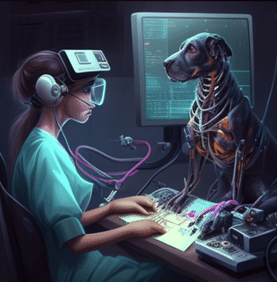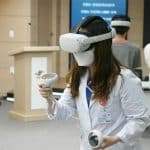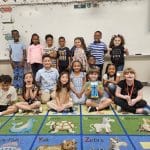March 26, 2023
Daren White | @Ranga_EDU
March 2023

Yesterday – Today – Tomorrow
Context
This article was written in retrospect of the LGFL Let’s Assemble Conference in London.
I began my school life firmly in the ‘Thatcher Years’ shortly after comprehensivism had been eradicated by the 1979 Education Act, and subsequently by the 1980 Education Act which introduced the Assisted Places Scheme, providing public money to allow 30,000 pupils to go to private schools.
The scheme cost around £6m in its first year and around £70m when fully operational – was paid for out of the general education budget: in other words, from funds that would otherwise have been available to local authorities and their schools.
The former Tory Prime Minister, Edward Heath, was not in favour at all. Heath believed that “a policy of taking the highest fliers from the state sector would have an unacceptably debilitating impact on those who remained”.
He argued the case for the young people who would have to be the first to endure this experiment in social engineering. After all, these youngsters were the leaders of the future, and their loss would lower the standards of their schools all round. Heath also believed that the main motivation behind the proposal was to support private schools known to be in financial difficulties.
The government’s other aims at that time were to make the education system more responsive to the needs of industry and more susceptible to market forces.
Admirable intentions back in the 1980s, but to quote 5-year-old me in the back of a Triumph Dolomite “are we nearly there yet?”
I think we must have broken down on the hard shoulder somewhere along the road.
To achieve these aims, Thatcher and her administration set about challenging teachers, unions, local authorities, training institutions, inspectors, and advisors with action on four main issues:
- giving parents more control over schools
- increasing central government influence over what was taught in schools.
- controlling teacher training and development and restricting their role in curriculum development
- reducing Local Authority power to stray from central government policies.
Of course, at the age of 5 I had no idea about any of this, I was just sad I didn’t get a ⅓ pint bottle of milk each day anymore. I do however vaguely remember my parents being pleased to have a choice in what Primary School I would attend, because it meant I would be more likely to be with my friends from Mother & Toddler group.

The 1981 Education Act saw the introduction of a requirement to identify any Special Educational Needs of pupils. The concept of a ‘statement’ was born, but roll-out was hindered by the government’s penchant for budget-cuts. 1981 was also the starting point for the government gaining more and more control over the curriculum and what should be taught and promoted, including themes such as why we should keep nuclear weapons and being taught to ‘know your place’. [1] It was a strange time by all accounts, I’m glad I was oblivious to it.
[1] quoted in Ranson 1984:241, via http://www.educationengland.org.uk/history/chapter15.html
Yesterday’s World
When I began school in the autumn of 1981 I don’t recall very much in terms of technology in the classroom. The closest we would get, would be 30 of us huddled around a 20” TV set watching BBC Schools and Colleges. Learning must have been built around the TV schedule so that we didn’t miss the start of the latest episode of Look and Read, and to be honest, these are some of my fondest memories of Primary school, watching Wordy teaching us about ‘Magic E’ , being scared out of our wits by the tales from the Dark Knight’s Folly or freaking out at the Thin Man in the Boy from Outer Space.
It wasn’t until I got to secondary school in 1987 that I really began to notice ‘technology’ for the first time.
I’d had an Atari 2600 for a while and was a bit of a whizz on Pacman and Pitfall, and my cousin had a Vic20 that we would load up with Paperboy over a period of about an hour just to play a 10-minute game before it was time to go home. So, when our school got the first BBC computers in classrooms, we thought it was like something out of Star Trek. It turned out to be more like something that barely any of us ever got to use as there was only one, it took ages to start up and generally, no-one was really sure what we were supposed to be doing with it.
We had some cool machines in CDT (Craft, Design & Technology) and I fondly remember making buggies out of balsa wood with drinks cans as wheels as well as moulding something called perspex into a milk indicator for our doorstep (google it). Aside from that though, we were still wheeling in a TV on a trolley, albeit with a Betamax toploading video recorder on the lower shelf to watch any content that wasn’t to be purely delivered didactically by our teacher. Blackadder was a favourite in History lessons!

Personalised learning wasn’t a thing at all. I would have killed for some extension work in Maths where I’d finished the then ‘new GCSE content’ by the end of Year 10. What I got instead was an open pass to the Maths book cupboard where I could choose any textbook and then mark my own work from the answers at the back. Cosmic!
When I took my GCSE options IT was on offer, but it was clear that teachers weren’t keen and we were actively dissuaded. In fact, I still remember being told “IT will be a flash in the pan”. And so, at that time, with parental and teacher advice I chose to pursue other avenues, despite my interest in the possibilities.
Skip forward to 1998 and I’m at Portsmouth University, using desktop computers in a huge lab with around 60 other students, writing our dissertations. We had the help of ‘Clippy’ if we got stuck and we all thought it was cool. I’d used a range of technology throughout my language degree, especially audio-visual equipment which were revolutionary in terms of learning and mastering foreign language learning at your own pace. It was at this point I decided, teaching was a career I’d be keen to pursue, and so I applied and the rest as they say, is history.
In my first teaching placement, I discovered that Banda machines still existed in some schools (and reminisced about that smell). I also discovered that computers hadn’t really got much further than the odd one in each room and that OHPs were king. I must have spent a small fortune on non-permanent and permanent OHP markers, acetates and glue sticks in my first few years. My lesson planning was often cutting and sticking to make worksheets or photocopying one of many already in the 20 filing cabinets in the department office. I did have the luxury of a fixed whiteboard, but this was not common across the school, with many colleagues still rolling round their dark green chalkboards and coming home covered in dust.
It was in around 2007 that I got my first interactive whiteboard complete with pen. I remember it well because I was clearly told by my Head of Department “The technology is all in the pen so don’t lose it, we can’t afford to replace it”. Genius design!
I embraced my board and new brick laptop and took the opportunity to try new things and teach other colleagues too. I must confess though that I did convince a number of classes that every now and again I needed to take a moment to hold the pen on the colour palette on screen in order to download some more ink. It was this opportunity to try new tools, largely without any training of my own, that sparked my interest in innovation and training.
Today’s World.
Fast forward to now and things have changed immeasurably in relatively little time. Here are just some of the things we rely on every day that did not exist when I began my career:
- Camera phones
- iPhones (2007) and Android Smartphones (2008)
- Google (1998)
- Wifi
- Facebook, Twitter, LinkedIn
- Podcasts
- PayPal
- Wikipedia
- Netflix
- Bluetooth (2004)
- Youtube (2005)
- USB Flash Drives

RECOMMENDED: https://global-edtech.com/category/edtech-market/
and here are some that just weren’t even a thing just 10 years ago:
- iPads
- GPS on phones
- Airbnb
- Spotify
- Crowdfunding
- Uber
- Blockchain and Cryptocurrency
- Waze and other traffic sensitive GPS (OMG – what a lifesaver!)
- 4G (let alone 5G)
Looking at that list, how much of those are now fundamental parts of our everyday lives? Technology and society have changed so much in that time, but can we confidently say the same about education?
Look how quickly the interest in the use of AI in Education has exploded since November 2022 with tools like chatGPT, Google Bard, image and video generation tools, voice generation and cloning and more. We are in a pivotal moment that will define history.
Image: AI generated original image of a robot teaching a class to cook. (midjourney)
So, what might cutting edge technology look like in 25 years’ time?

Tomorrow’s World?
Firstly, we have to accept that the progress timeline has sped up to hyperdrive. The amount of innovation we experience daily these days dwarfs that which was experienced in the 1980s (although if you watch old episodes of the BBC’s Tomorrow’s World on Youtube or BBC Archive you’ll see just how scarily good they were at predicting the technology and lifestyle of the future). Therefore, the development and progress we can expect in the next 25 years is probably beyond imaginable.
Here are some potential growth areas to consider (inspired by Sciencefocus.com)
- Necrobotics – taking dead things and bringing them ‘back to life’ by fusing with robotics (currently being explored at Rice University)
- Sand batteries – Finnish engineers are currently developing these as a more sustainable alternative to standard and Lithium batteries
- Intelligent exo-skeletons – designs like the Atlas 30 from marsi-bionics will become more widely available to support those with developmental disabilities.
- Xenotransplantation – transplanting, implementing, or infusing a human with cells, tissues or organs from an animal source
- Brain-reading robotics – paraplegic patients being able to control robotic limbs with their thoughts in order to interact more fully with the world around them
- 3D printed bones – we’re already seeing 3D printed artificial limbs being developed to help amputees, but bone replacement and reconstruction will become commonplace
- Digital ‘twins’ – digital versions of ourselves, on a smartphone app, monitoring our bio signs, identifying, and alerting us at the first sign of any issues of ill health, both physical and mental.
The possibilities are endless and that’s what is so exciting!
It’s also true that some things we imagined 25 years ago still haven’t come to fruition Some have been sent to the graveyard, others have been surpassed and a number may still be in development, waiting in the wings. Whatever happens, I think we can all agree that societal and environmental crises dictate that we will undoubtedly see a surge in innovation and development around sustainability, climate, fuel, and health.
Impact on Jobs & Careers
Looking back now, how well did my primary and secondary education prepare me for my career and subsequent life?
I’d have to say I think the impact is minimal. Yes, there were teachers who were great, and those that weren’t. There were probably great lessons that I don’t remember and rubbish ones that I do but what about skills?
I genuinely think that the most valuable attributes like work ethic came from my parents, innovation, problem solving and critical thinking from my time in the Scout Association and exploration from travel with my parents and with college and university.
Did careers education do anything for me at school? If I’m honest, 3 weeks of work experience in my old primary school was creative and fun and certainly didn’t put me off teaching but aside from that, I don’t recall anything of note.
At the start of the millennium the jobs below, like so many others, did not even exist, yet today, less than 25 years later, they are commonplace and indeed pivotal. 13-year-old me would not have contemplated anything like this at the time, and yet I now regularly interact with people in many of these roles and in some cases, fulfil part of them myself even though that was never to focus of my studies or career until fairly recently.
- AI engineer
- Data Scientist
- UX Designer (User Experience)
- Mobile App Developer
- Social Media Manager
- Social Influencer
- Blogger/Vlogger
- Digital Strategist
- Podcaster/ Producer
AI Image: Necrobotic Surgeon completing an operation to fuse a deceased dog with robotics in order to further medical research (midjourney)

Question – We must ask ourselves:
What are we doing today, as educators, to ensure we prepare young people for their tomorrow, and not what will actually be their yesterday?













